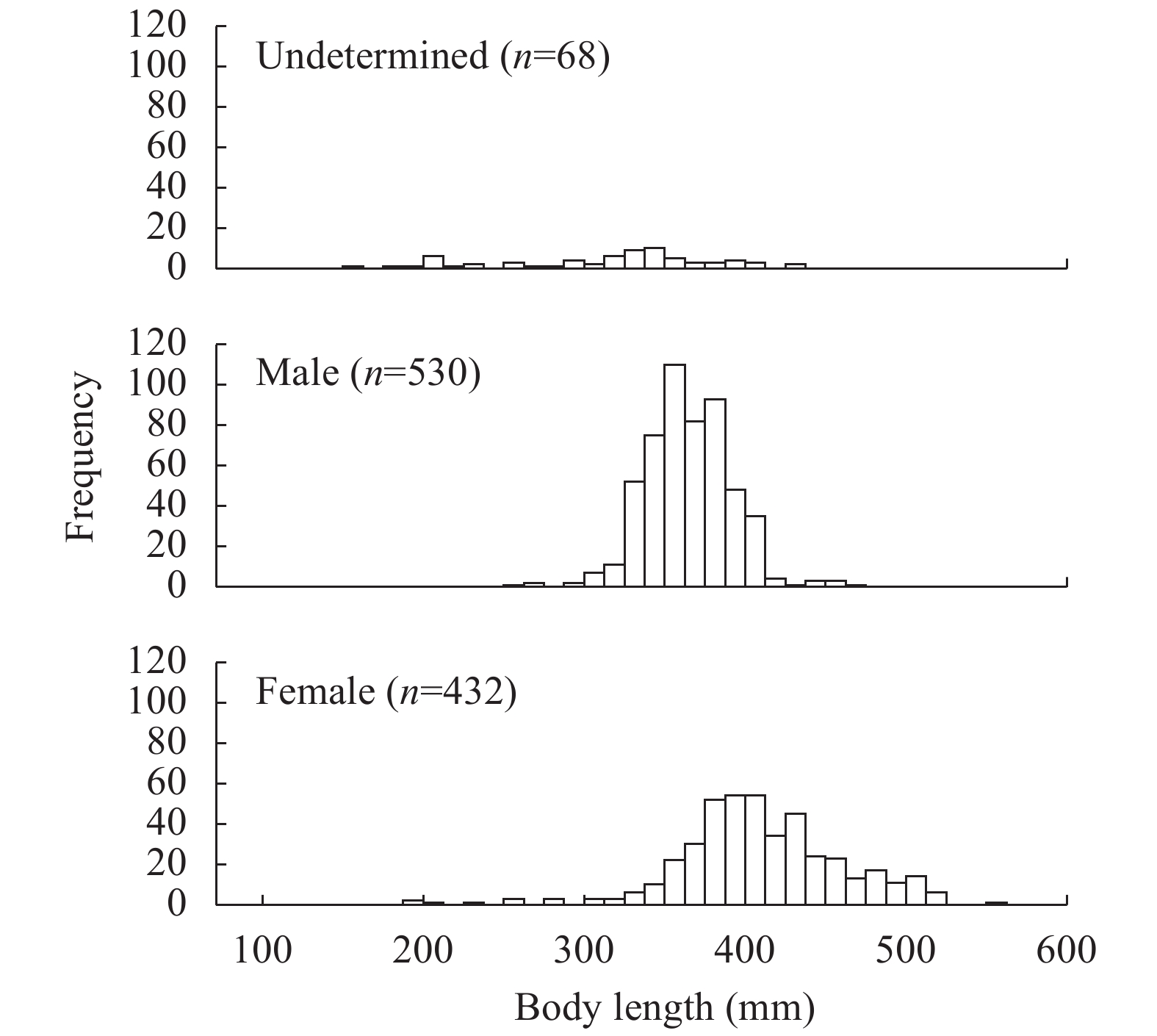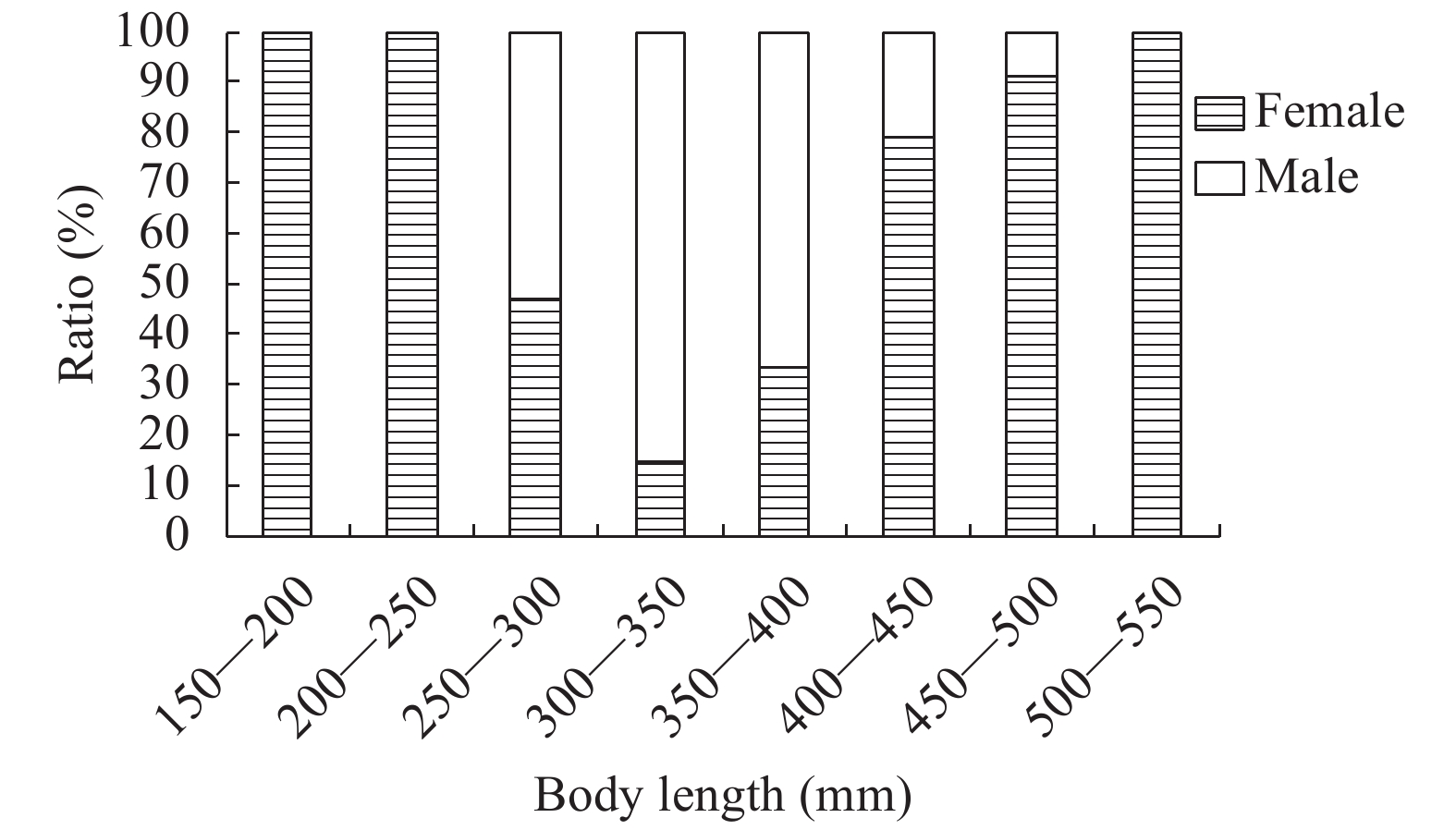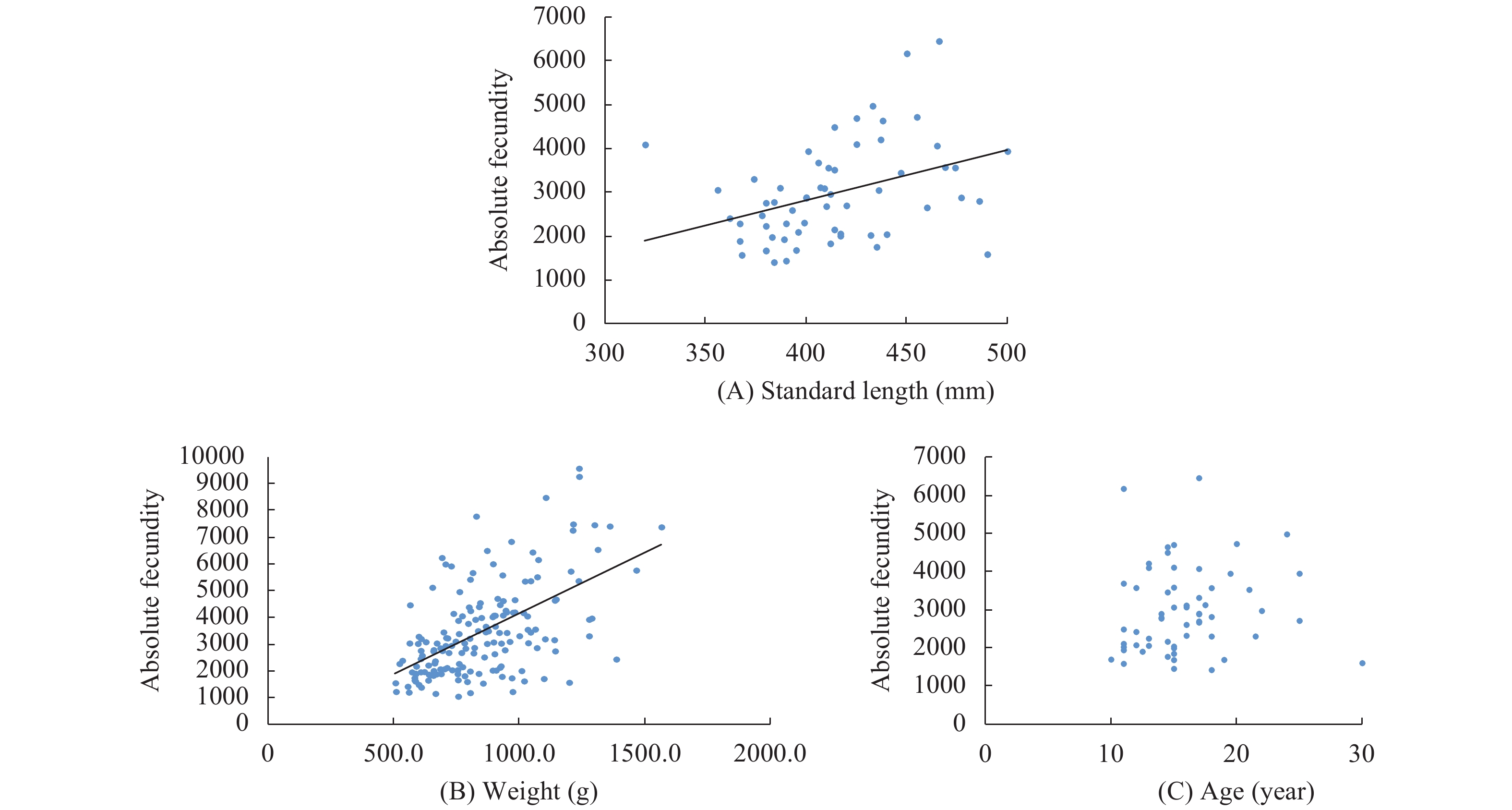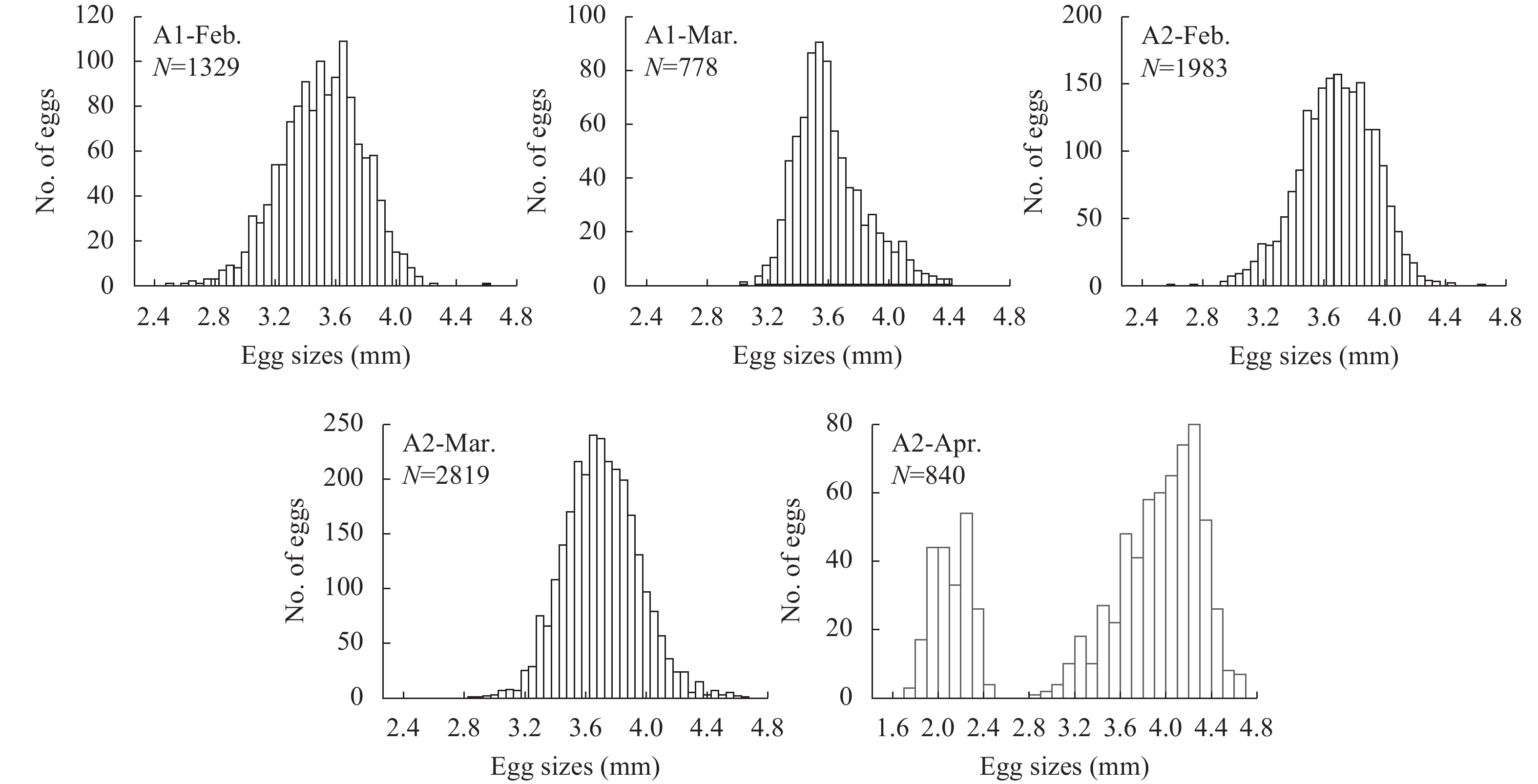FECUNDITY AND REPRODUCTIVE STRATEGY OF PTYCHOBARBUS DIPOGON POPULATIONS FROM THE MIDDLE REACHES OF THE YARLUNG ZANGBO RIVER
-
Abstract: The Ptychobarbus dipogon of the Schizothoracinae subfamily, is an endemic economic fish species in Tibet Autonomous Region, China. Due to environment deterioration and invasion of alien species the population size of this species is decreasing; a study is urgently required to determine fecundity and reproductive strategy in order to conserve this natural resource. In this study, to investigate the fecundity and its relationship of body length, weight and age, we captured 1030 individuals in the middle Yarlung Zangbo River during two separate periods, one from February to March in 2013 and the other from February to June in 2014. The results showed that the standard length (SL) of males is concentrated in the 325—400 mm range, and the SL of females is above 375 mm. Sixty five females were at stages IV and V of sexual maturity, with SL 320—500 mm, weight 411.6—1328.0 g. Using the SL 50% method, the first female sexual maturity age was estimated to be 13.0 years and about 360.90 mm, while the first male maturity age was estimated to be 13.5 years and length 354.53 mm. The distributions of egg sizes, gonadal developmental stages and gonadosomatic indexes show that this species follows a synchronous spawning pattern concentrated in the period February to March, with an absolute fecundity at 3487 eggs, with a fecundity to SL ratio of 7.2 eggs/mm and fecundity to weight of 4.3 eggs/g. The absolute fecundity is positively correlated to the SL and the weight, but not significantly correlated to age. The overall male-female ratio was 1.23 鲶1. Suggestions for its conservation have been made based on its low fecundity, late maturity and short breeding period.
-
Keywords:
- Tibet Autonomous Region /
- Ptychobarbus dipogon /
- Fecundity /
- Reproductive strategy
摘要: 双须叶须鱼Ptychobarbus dipogon隶属裂腹鱼亚科, 叶须鱼属, 是西藏特有经济鱼类, 研究通过对其繁殖力和繁殖策略的研究, 旨在为双须叶须鱼的科学保护和合理开发提供理论依据。于2013年2月至3月以及2014年2月中旬至6月中旬, 在雅鲁藏布江中游区段采集到1030尾双须叶须鱼, 雄鱼体长主要集中在325—400 mm, 雌鱼体长主要集中在375 mm以上, 其中Ⅳ期、Ⅴ期的雌鱼65尾, 体长为320—500 mm, 体重为411.6—1328.0 g。采用SL50%的方法, 雌鱼初次性成熟体长为360.90 mm, 初次性成熟年龄为13.0龄; 雄鱼初次性成熟体长为354.53 mm, 初次性成熟年龄为13.5龄。从不同月份不同性腺发育期所占比例, 不同月份的性体指数变化以及不同月份卵径分布图, 可以看出双须叶须鱼属于同步产卵类型, 集中在2—4月份。双须叶须鱼平均绝对繁殖力为3487粒, 平均相对体长繁殖力为7.2粒/mm, 平均相对体重繁殖力为4.3粒/g, 绝对繁殖力与体长、体重呈正相关, 与年龄无显著相关性。群体性比为1.23 鲶1。综上所述, 双须叶须鱼是繁殖力较低、性成熟较晚和繁殖期较短的鱼类, 我们针对其繁殖特性提出了一些保护性建议。 -
-
Table 1 Characteristics of gonadal development in P. dipogon
Gonadal developmental stages Ovaries Testes Ⅰ Gonads are undeveloped, appearing as translucent wires on the abdomen close to the swim bladder. Sex cannot be determined visually. No visible eggs. No blood vessels on the surface Similar to the stage I ovaries Ⅱ Development has started. Each ovary is generally a flattened, semi-translucent stripe, with a slightyellow hue under light. No visible eggs. Sex can be determined visually. Small amounts ofvessels, not highly visible Development has started. Each testis is generally a thin, semi-translucent stripe, with a white hue under light. Sex can be determined visually Ⅲ Gonads are maturing. Each ovary is cylindrical in the middle, appearing as thick, flattened stripes in both ends, light yellow in color. White or light yellow eggs with yolk are visible. When dissected, the eggs are neither large nor round, and difficult to remove from the ovariolar sheath Gonads are maturing. Each testis is a gray-white thick and flattened stripe in the back end, and rod-like in the middle and front end. Its surface is divided into lobules. No semen leaks out when the abdomenis lightly depressed Ⅳ Gonads nearing maturity. The ovaries take up a thirdof the body cavity. Eggs are highly visible as orange-yellow spheres. When dissected, eggs are easy to remove from the sheath. Eggs are separate from each other Gonads nearing maturity. The testes take up a third of the body cavity, and are milky in color. No semen leaks out when the abdomen is lightly depressed Ⅴ Gonads fully matured. The ovaries take up 1/3—1/2 of the body cavity. Eggs are highly visible and orange-yellow. When dissected, eggs are round and full, already detached from the sheath and have free movement in the ovariolar cavity. Eggs will leak out from the cloaca if the fish is lifted by its head, and the abdomen is lightly depressed Gonads fully matured. The testes are milky and filled with semen, taking up 1/3—1/2 of the body cavity. Their surfaces have highly visible vessels. Semen will leak out from the cloaca if the fish is lifted by its head, and the abdomen is lightly depressed Ⅵ Post-spawning. The ovaries are dark red and shrunken. The ovariolar sheath is loose and thickened. When dissected, most eggs are white and small, with only small amounts of matured eggs remaining. When the abdomen is lightly depressed, only few eggs and yellow sticky matter will leak out. Eggs are round and slightly flattened Post-spermiation. The testes are shrunken. When the abdomen is lightly depressed, only translucent mucous leaks out, rather than white semen Table 2 Female GSI values of P. dipogon between sampling areas and periods
Sampling area and period N GSI (%) A1-Feb. 2013 12 7.862±3.047ab A1-Mar. 2013 6 8.313±2.687a A2-Feb. 2014 49 5.162±4.517bc A2-Mar. 2014 62 5.269±4.970bc A2-Apr. 2014 205 2.574±1.758cd A2-May 2014 38 2.66±1.747cd A2-June 2014 9 1.985±1.043d Note: N denotes sample size. Within the same column, items with different superscript letters have significant differences (P<0.05) Table 3 Variations of male/female fatness for P. dipogon for different months
Month Female fatness (K) Male fatness (K) N Mean±S.D. N Mean±S.D. Feb. 58 1.038±0.100b 57 1.019±0.129c Mar. 89 1.095±0.122b 144 1.110±0.113b Apr. 218 1.120±0.193b 190 1.101±0.118b May 43 1.101±0.231b 85 1.095±0.131b June 9 1.258±0.375a 47 1.162±0.100a Note: N denotes sample size. Within the same column, items with different superscript letters have significant differences (P<0.05) Table 4 Fecundity of P. dipogon
Fecundity Mean±SD No. of individuals Range Absolute fecundity (eggs) 3487.3±1730.5 166 1078.4—9589.6 Relative fecundity to SL (eggs/mm) 7.2±2.5 60 3.2—13.9 Relative fecundity to weight (eggs/g) 4.3±1.4 166 1.6—7.6 Standard length (mm) 413.4±36.9 60 320—500 Weight (g) 853.5±214.6 166 507.0—1566.0 Table 5 Comparison of first sexual maturity ages among cold-water Schizothoracine fishes
Species Female first sexual maturity age (year) Male first sexual maturity age (year) Source Schizothorax yunnanensis Norman 3 2 Xu, et al.[41] Schizothorax davidiSauvage 5 3 Peng, et al.[42] Schizothorax waltoniRegan 13.5 10.2 Zhou[29] Schizothorax biddulphiGünther 4+ 3+ Nie, et al.[43] Schizothorax sineusis Herzenstein 5 4 Leng[36] Schizothorax oconnori Llord 16.2 12.5 Ma[32] Ptychobarbus dipogon Regan 13 13 Li, et al.[5] Ptychobarbus dipogon Regan 13.0 13.5 This study Gymnodiptychus dybowskii Kessler 3.4 2.5 Niu[44] Gymnocypris chilianensis Li et Chang 5 5 Wang[45] Gymnocypris selincuoensis 9 8 Chen, et al.[46] Oxygymnocypris stewartiiLloyd 7.3 5.1 Huo[31] Table 6 Comparison of absolute fecundities of cold-water Schizothoracine fish
Species Absolute fecundity (No. of eggs) Sampling Location Source Schizothorax yunnanensisNorman 10980 Miju River Xu, et al.[41] Schizothorax waltoni Regan 21693 Yarlung Zangbo River Zhou[29] Schizothorax biddulphi Günther 1983—11894 Weigan River Nie, et al.[43] Schizothorax lissolabiatus Tsao 4049 Pearl River system, Beipan River Xiao and Dai [47] Schizothorax sineusis Herzenstein 7563 Jialing River system, upper Leng[36] Schizothorax prenantiTchang 25600 Sichuan Yaan Fish Breeding Co. Zhou, et al.[48] Schizothorax grahana Regan 10000—15000 Wu & Chishui Rivers, upper Zhan, et al.[49] Schizothorax oconnoriLlord 21190 Yarlung Zangbo River Ma[32] Schizothorax kozlovi Nikolsky 8681 Wu River, upper Chen, et al.[33] Ptychobarbus dipogonRegan 4597 Lhasa River Li, et al.[5] Ptychobarbus dipogon Regan 3487 Lhasa River This study Gymnodiptychus pachycheilusHerzenstein 3043—42158 Yellow River, upper Lou, et al.[50] Gymnodiptychus dybowskii Kessler 3087 Ili River, tributary of Niu[44] Gymnocypris przewalskii Kessler 4338 Qinghai Lake Zhang, et al.[51] Gymnocypris chilianensisLi et Chang 4236 Qilianxue Nursery Wang[45] Gymnocypris waddellii Regan 4446 Yamdrok Lake Yang[52] Gymnocypris selincuoensis 12607 Siling Lake Chen, et al.[46] Oxygymnocypris stewartii Lloyd 34211 Yarlung Zangbo River Huo[32] Schizopygopsis chengi Fang 2659 Zhuosijia River Hu[53] Schizopygopsis stoliczkae Steindachner 19380 Sengge River Wan[34] Platypharodon extremusHerzenstein 12630 Yellow River, upper, segment in Maqu County Zhang, et al.[54] -
[1] Yang H Y, Huang D M. A preliminary investigation on fish fauna and resources of the upper and middle Yalu Zangbo River [J]. Journal of Huazhong Normal University(
Natural Sciences ) , 2011, 45(4): 629—633 (in Chinese) [2] Chen F, Chen Y F. Investigation and protection strategies of fishes of Lhasa River [J]. Acta Hydrobiologica Sinica, 2010, 34(2): 278—285 (in Chinese)
[3] Luo S, Bu D, Dan Z, et al. Fatty acid composition and nutrition evaluation in muscle of three freshwater fish [J]. Freshwater Fisheries, 2009, 39(6): 74—76 (in Chinese)
[4] Ji Q. The study on the morphology of feeding organs and the feeding habits of six Schizothoracine fishes [D]. Wuhan: Huazhong Agricultural University. 2008 (in Chinese)
[5] Li X Q, Chen Y F, He D K. Reproductive strategy of Ptychobarbus dipogon in the Lhasa River, Xizang [A]. Abstract assembly of seminar thesis from Chinese Ichthyological Scoiety in 2008 [C]. Chinese Ichthyological Society. 2008 (in Chinese)
[6] Wu Y F, Kang B, Meng Q, et al. Chromosome diversity of Tibetan fishes [J]. Zoological Research, 1999, 20(4): 258—264
[7] Yang X. Study on age, growth, feeding habits and population dynamics of Ptychobarbus dipogon in the Yarlung Zangbo River [D]. Wuhan: Huazhong Agricultural University. 2015 (in Chinese)
[8] Li X Q, Chen Y F. Age structure, growth and mortality estimates of an endemic Ptychobarbus dipogon (Regan, 1905) (Cyprinidae: Schizothoracinae) in the Lhasa River, Tibet [J]. Environmental Biology of Fishes, 2009, 86(1): 97—105
[9] Li X Q, Chen Y F, He D K, et al. Otolith characteristics and age determination of an endemic Ptychobarbus dipogon (Regan, 1905) (Cyprinidae: Schizothoracinae) in the Yarlung Zangbo River, Tibet [J]. Environmental Biology of Fishes, 2009, 86(1): 53—61
[10] Havelka M, Bytyutskyy D, Symonova R, et al. The second highest chromosome count among vertebrates is observed in cultured sturgeon and is associated with genome plasticity [J]. Genetics Selection Evolution, 2016, 48: 12
[11] Huo T B, Li L, Wang J L, et al. Length-weight relationships for six fish species from the middle of the Yalu Zangbo River, China [J]. Journal of Applied Ichthyology, 2015, 31(5): 956—957
[12] Zhang G R, Ji W, Shi Z G, et al. The complete mitogenome sequence of Ptychobarbus dipogon (Cypriniformes: Cyprinidae) [J]. Mitochondr DNA, 2015, 26(5): 710—711
[13] The qinghai-tibet plateau comprehensive scientific expedition from Chinese Academy of Sciences. Ages, Amplitudes and Form Problems during the Uplift of the Qinghai-Xizang Plateau [M]. Beijing: Science Press. 1981, 118—130
[14] He D K, Chen Y F, Chen Y Y, et al. The relationship between molecular phylogeny and uplift of the Qinghai-Xizang Plateau for Specialized schizothoracine fishes [J]. Chinese Science Bulletin, 2003, 48(22): 2354—2362 (in Chinese)
[15] Wang X Z. Molecular phylogeny of the East Asian Cyprinids (Pisces: Cyprinidae) [D]. Wuhan: Institute of Hydrobiology, Chinese Academy of Sciences. 2005 (in Chinese)
[16] Yang T Y, Meng W, Zhang R M, et al. Comparative analysis of mtDNA gene between two rare Schizothoracine fishes [J]. Chinese Journal of Zoology, 2011, 46(3): 47—54 (in Chinese)
[17] Zhang M M, Miao D S. Review of the cenozoic fossil fishes from the Tibetan plateaau and their bearings on paleoenvironment [J]. Chinese Science Bulletin, 2016, 61(9): 981—995
[18] Wu Y F, Chen Y Y. Fossil cyprinid fishes from the late tertiary of north Xizang, China [J]. Vertebrata Palasiatica, 1980, 18(1): 15—20
[19] Zhang C G, Cai B, Xu T Q. Fish and fishery in Xizang [M]. Beijing: China Agriculture Press. 1995, 1—162 (in Chinese)
[20] Liu H P, Ye S W, Li Z J. Length-weight relationships of three schizothoracinae fish species from the Niyang River, a branch of the Yarlung Zangbo River, Tibet, China [J]. Journal of Applied Ichthyology, 2016, 32(5): 982—985
[21] Chen Y F, Cao W X. Schinzothoracinae [A]. In: Yue P Q, et al. (Eds.), Fauna Sinaica Osteichthyes Cypriniformes III [C]. Beijing: Science Press. 2000, 273—274 (in Chinese)
[22] Wu Y F, Wu C Z. The Fishes in Qinghai-Xizang Plateau [M]. Chengdu: Sichuan Science and Technology Press. 1992, 1—599 (in Chinese)
[23] Tang W J, Shen Z X, Jian S L. The rare and endangered fishes and their conservation strategies in Huanghe River, Qinghai [J]. Journal of Hydroecology, 2006, 26(1): 57—60
[24] Chen Y F. Phyletic evolution and resources biology of Schizothoracine fishes [D]. Wuhan: Institute of Hydrobiology, Chinese Academy of Sciences. 2000 (in Chinese)
[25] Li H J. Studies on the biology and population ecology of Glyptosternum maculatum Regan in the Brahmaputra River, China [D]. Wuhan: Huazhong Agricultural University. 2008 (in Chinese)
[26] Zhou X J, Xie C X, Huo B, et al. Reproductive biology of Schizothorax waltoni (Cyprinidae: Schizothoracinae) in the Yarlung Zangbo River in Tibet, China [J]. Environmental Biology of Fishes, 2015, 98(2): 597—609
[27] Yellow Sea Fisheries Research Institute. Handbook of Ocean Fishery Investigation (The Second edition) [M]. Shanghai: Shanghai Science and Technology Press. 1981, 1—530
[28] Yin M C. Fish Ecology [M]. Beijing: China Agriculture Press. 1995, 1—293 (in Chinese)
[29] Zhou X J. Study on the biology and population dynamics of Schizothorax waltoni [D]. Wuhan: Huazhong Agricultural University. 2014 (in Chinese)
[30] Xiong F. Reproductive biology of Gymnocypris przewalskii [D]. Wuhan: Huazhong Agricultural University. 2003 (in Chinese)
[31] Huo B. Study on the biology and population dynamics of Oxygymnocypris stewartii [D]. Wuhan: Huazhong Agricultural University. 2014 (in Chinese)
[32] Ma B S. Study on the biology and population dynamics of Schizothorax o’connori [D]. Wuhan: Huazhong Agricultural University. 2011 (in Chinese)
[33] Chen Y X, Luo Q S. The fecundity of Schizothorax kozlovi from Wu River [J]. Zoological Research, 1995, 16(4): 324, 342, 328
[34] Wan F J. Aquatic biotic resources and biology of Schizopygopsis stoliczkai stoliczkai Steindachner in Shiquan River [D]. Wuhan: Huazhong Agricultural University. 2004 (in Chinese)
[35] Hu A, Tang S S, Gong S X. Reproductive biology of Gymnocypris przewalskii [A]. In: Institute of biology research, Qinghai, Fish fauna in Qinghai lake area and biology of Gymnocypris przewalskii [C]. Beijing: Science Press. 1975, 49—64 (in Chinese)
[36] Leng Y Z. Biology datas of Schizothorax sinensis [J]. Journal of Zoology, 1984, 6(15): 45—47
[37] Zhou C P. Reproduce biology of Schizopygopsis malacanthus baoxingensis [D]. Chengdu: Sichuan Agricultural University. 2007 (in Chinese)
[38] Shi J Q, Qi H F, Yang J X, et al. Study on breeding biology of Gymnocypris przewalskii [J]. Qinghai Science and Technology, 2000, 7(2): 12—15 (in Chinese)
[39] Sinovcic G, Kec V C, Zorica B. Population structure, size at maturity and condition of sardine, Sardina pilchardus (Walb., 1792), in the nursery ground of the eastern Adriatic Sea (Krka River Estuary, Croatia) [J]. Estuarine Coastal and Shelf Science, 2008, 76(4): 739—744
[40] Wootton R J. Ecology of Teleost Fishes [M]. Landon: Champman and Hall. 1990, 1—399
[41] Xu W Y, Liu Y T, Leng Y, et al. Reproductive biology of Schizothorax yunnanensis [J]. Journal of Hydroecology, 2006, 26(2): 32—33
[42] Peng Q, Wu B, Chen B, et al. Study on gonad development and preliminary artificial propagation of wild Schizothorax (Racoma) davidi (Sauage) [J]. Oceanologia et Limnologia Sinica, 2013, 44(3): 651—655 (in Chinese)
[43] Nie Z L, Wei J, Ma Z H, et al. The biology of Schizothorax biddulphi in Weigan River [A]. Abstract assembly of seminar thesis from China Society of Fisheries in 2011 [C]. China Society of Fisheries, 2011 (in Chinese)
[44] Niu Y J. Study on the individual biology of Gymnodiptychus dybowskii Kessler in the Ili River [D]. Alaer: Tarim University. 2015 (in Chinese)
[45] Wang W L. Study of Gymnocypris chilianensis artificial reproduction technology, embryonic development and the rule of oxygen [D]. Lanzhou: Gansu Agricultural University. 2014 (in Chinese)
[46] Chen Y F, He D K, Cai B, et al. The reproductive strategies of an endemic Tibetan fish, Gymnocypris selincuoensis [J]. Journal of Freshwater Ecology, 2004, 19(2): 255—262
[47] Xiao H, Dai Y G. Study on individual fecoundity of Schizothorax lissolabiatus in Beipan River [J]. Journal of Hydroecology, 2010, 3(3): 64—70
[48] Zhou B, Long Z H, He B. Study on reproductive biology of Schizothorax prenanti [J]. China Journal of Agricultural Sciences, 2013, 26(2): 811—813 (in Chinese)
[49] Zhan H X, Zhou L J, Yan H, et al. Biology characteristics and flow water breeding technology of Schizothorax grahami [J]. China Fisheries, 2011, 9: 29—30 (in Chinese)
[50] Lou Z Y, Qin Y, Wang T. Reproductive biology and spawning habitats of Gymnodiptychus pachycheilus [J]. Fisheries Science, 2012, 31(1): 32—36
[51] Zhang X, Xiong F, Tang H Y, et al. Study on reproductive biology of Gymncypris przewalskii [J]. Marine Fisheries Research, 2005, 26(3): 61—67
[52] Yang H Y, Huang D M, Chi S Y, et al. Reproductive biology of Gymnocypris waddrllii Regan in Yanmdrok region [J]. Journal of Lake Sciences, 2011, 23(2): 277—280 (in Chinese)
[53] Hu H R. Studies on age and groeth characteristics and reproductive biology of Schizopygopsis malacanthus Chengi in Chuosjia River [J]. Wuhan: Huazhong Agricultural University. 2012
[54] Zhang Y P, Lou Z Y, Su J H, et al . Artificial propagation of Platypharodon extremus [D]. Journal of Fisheries of China, 2010, 34(11): 1698—1703 (in Chinese)
[55] Lam T J. Environmental Influences on Gonadal Activity in Fish [A]. In: Hoar W S (Eds.), Fish Physiology [C]. London: Academic Press. 1983, 65—66
[56] ShPigel M, MeBride S C, Mareiano S, et al. The effect of photoperiod and temperature on the reproduction of European sea urehin Paraeentrotus lividus [J]. Aquaculture, 2004, 232(1-4): 343—355
[57] Shi L F. Fish Physiology [M]. Beijing: China Agriculture Press. 1991, 1—442 (in Chinese)
[58] Hu Y H. Analysis of laohuizui hydro-power station environment influence, Xizang [J]. Water Conservancy Science and Technology and Economy, 2009, 15(12): 1069—1070 (in Chinese)
[59] Xiao C W, He J, Xiang F. The influence on river ecology and ecological operation countermeasures during reservoir regulation of Lhasa River [J]. Water Resources Development Research, 2013, 7: 14—19
[60] Zhang L. Geological characteristics of yulong copper mine in Tibet and the environmental impact of mining [D]. Chengdu: Chengdu University of Technology. 2011
-
期刊类型引用(7)
1. 刘铠源,段勇杰,程浩,吕俊贤,谢婷,李娟,关长涛,贾玉东. 斑石鲷(Oplegnathus punctatus)、云龙石斑鱼(Epinephelus moara♀×E.lanceolatus♂)、许氏平鮋(Sebastes schlegelii)游泳行为对比分析研究. 海洋与湖沼. 2024(03): 555-565 .  百度学术
百度学术
2. 段勇杰,谢婷,高云涛,王枫林,李梦迪,关长涛,贾玉东. 斑石鲷(Oplegnathus punctatus)游泳性能研究. 海洋与湖沼. 2023(01): 183-193 .  百度学术
百度学术
3. 张静静,王亚冰,王倩,韩多彩,彭士明. 不同抗流能力大黄鱼(Larimichthys crocea)肌肉转录组学差异分析. 海洋与湖沼. 2023(05): 1507-1516 .  百度学术
百度学术
4. 李新丹,肖新平,周卫国,罗江,周杨浩,荣义峰,祁洪芳,史建全,杜浩. 青海湖裸鲤的游泳能力及鱼梯通过效果. 渔业科学进展. 2022(02): 44-52 .  百度学术
百度学术
5. 蔡露,Katopodis Christos,金瑶,黄应平,韩德举,胡望斌,陈小娟,陶江平,侯轶群. 中国鲤科鱼类游泳能力综合分析和应用. 湖泊科学. 2022(06): 1788-1801 .  百度学术
百度学术
6. 孙春艳,曾令清. 颜色标记对两种鱼类有氧运动能力的影响. 重庆师范大学学报(自然科学版). 2020(03): 67-71 .  百度学术
百度学术
7. 朱峰磊,张敬敬,龙静,闫玉莲,谢小军. 游泳加速模式对南方鲇和团头鲂运动后代谢恢复的影响. 淡水渔业. 2020(03): 65-71 .  百度学术
百度学术
其他类型引用(4)




 下载:
下载:



